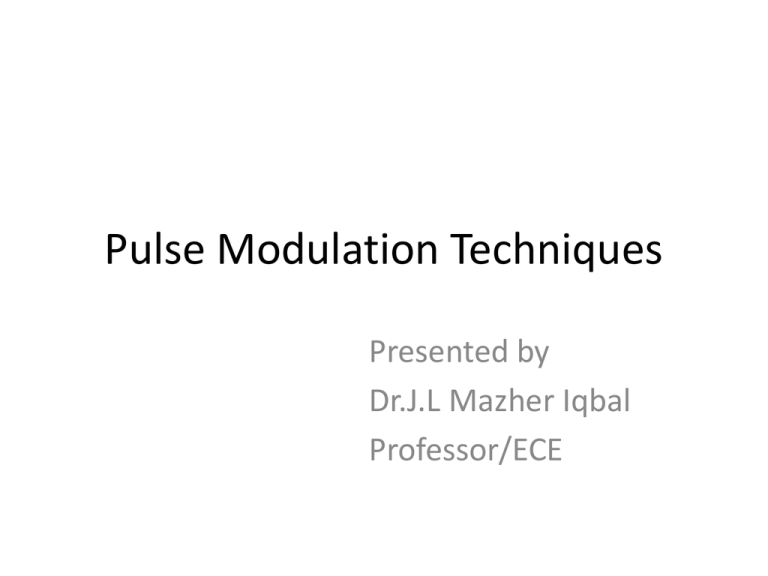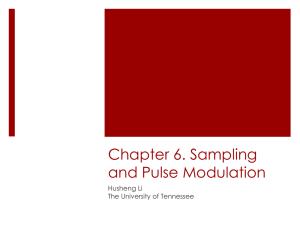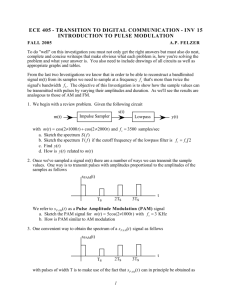Pulse Width Modulation
advertisement

Pulse Modulation Techniques Presented by Dr.J.L Mazher Iqbal Professor/ECE PULSE MODULATION Analog Pulse Modulation Digital Pulse Modulation Pulse Amplitude (PAM) Pulse Code (PCM) Pulse Width (PWM) Delta Modulation(DM) Pulse Position (PPM) 2 Sampling The process of transmitting signals in the form of pulses (discontinuous signals) by using special techniques. The signal is sampled at regular intervals such that each sample is proportional to the amplitude of signal at that instant. This technique is called “sampling”. Sampling is common in all pulse modulation techniques. Sampling Sampling Analog signal is sampled every TS secs. Ts is referred to as the sampling interval. fs = 1/Ts is called the sampling rate or sampling frequency. There are 3 sampling methods: Ideal - an impulse at each sampling instant Natural - a pulse of short width with varying amplitude Flat top - sample and hold, like natural but with single amplitude value Three different sampling methods Sampling Rate Sampling Theorem Nyquist showed that it is possible to reconstruct a band-limited signal from periodic samples, as long as the sampling rate is at least twice the frequency of the of highest frequency component of the signal i.e. fs ≥ 2fm where fs is sampling rate Sampling rates that are too low result in aliasing or fold over Pulse Modulation Techniques Pulse Amplitude Modulation • In PAM,amplitude of pulses is varied in accordance with instantaneous value of modulating signal. Pulse Amplitude Modulation The carrier is in the form of narrow pulses having frequency fs.The uniform sampling takes place in multiplier to generate PAM signal.Samples are placed Ts sec away from each other. Modulating Signal 10/31/2012 Low Pass Filter Multiplier Pulse train generator Punjab Edusat society PAM Signal 10 10 Pulse Amplitude Modulation • Depending upon the shape and polarity of the sampled pulses, PAM is of two types, • Natural PAM sampling occurs when top portion of the pulses are subjected to follow the modulating wave. Pulse Amplitude Modulation • Flat topped PAM sampling is often used because of the ease of generating the modulated wave. In this pulses have flat tops after modulation. PAM-Flat top sampling • PAM is obtained using sample and hold (S/H) technique. This approach produces flat top pulses. • S/H circuit consist of two FET switches and a capacitor. • A gate pulse at G1 closes the sampling switch and the capacitor holds the sampled voltage until discharged by a pulse applied G2. (1) Flat-top PAM (4) Pulse Amplitude Modulation • The PAM signal can be detected by passing it through a low pass filter. Fig.1. Detection of PAM and waveform 19 Pulse Width Modulation • In this type, the amplitude is maintained constant but the width of each pulse is varied in accordance with instantaneous value of the analog signal. Pulse Width Modulation Fig: Pulse Width Modulation • That is why the information is contained in width variation. This is similar to FM. • In pulse width modulation (PWM), the width of each pulse is made directly proportional to the amplitude of the information signal. Pulse Width Modulation PDM & PPM • The system employs a comparator and a saw tooth-wave generator with period Ts. • The output of the comparator is zero except when the message waveform x(t) exceeds the saw tooth wave in which case the output is positive constant A. • Comparator output produces PDM with trailing edge modulation of the pulse duration. • Position modulation is obtained by applying the PDM signal to a mono stable pulse generator that triggers on trailing edge at its input and produce short pulses of fixed duration. Pulse Width Modulation 25 Pulse Position Modulation • In this type, the sampled waveform has fixed amplitude and width whereas the position of each pulse is varied as per instantaneous value of the analog signal. • PPM signal is further modification of a PWM signal. Pulse Position Modulation 27 Conclusion • The main advantage of these pulse modulation schemes are better noise immunity and possibility of use of repeaters which makes communication more reliable and error free.



